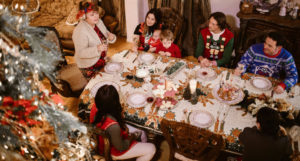New research reveals the Tudors were avid recyclers

Photo courtesy of The National Trust
Rich fabrics and fine embroidery seized from hundreds of churches closed by Henry VIII during the English Reformation were saved and repurposed through a remarkable recycling network that reached across all strata of 16th century society.
New research has uncovered how medieval church vestments, including some of the most luxurious Italian-imported fabrics, made their way into the homes and living spaces of Tudor society via a network which included government officials, merchants, craftspeople and extended families.
Officers from the Court of Augmentations, set up to manage the process of dissolving the monasteries and chantry chapels and to ensure that the Crown took most of their treasures, even kept a look-out for fine fabrics which they might like to keep for themselves.
These are the preliminary findings of a project called Textile Transmissions, which is being conducted by the National Trust and the University of Exeter and centres upon a collection of fabrics held at Hardwick Hall in Derbyshire, belonging to Elizabeth Talbot, Countess of Shrewsbury (1527–1608).
Best known as “Bess of Hardwick”, the Countess was renowned for her interior decoration of her mansion houses Chatsworth and Hardwick, where she invested lavishly in carpets, tapestries and embroideries. Her schemes have always been seen as the conspicuous consumption of the very latest fashions in art and design with the aim of positioning herself at the apex of Tudor society. But, the researchers say, the reality is more nuanced, and that these remarkable interiors were an expression of Bess’s own creative ingenuity, making modish new decorations from second-hand materials, continuing a tradition of recycling and upcycling which was age-old.
“On first encounter, the embroidered textiles that survive today at Hardwick appear to carry the hallmarks of artwork from the end of the Tudor era, their subjects taken from Roman and Old Testament history, and their style copying the classicism of the European Renaissance,” said Emma Slocombe, Senior National Curator at the National Trust. “Yet seen in close-up, the appliqué hangings reveal a remarkable secret: each one is made from fabric and figures cut from textiles originally made for a quite different purpose. In fact, Bess’s textiles began life decades before she embarked on the decoration of her great houses as clergy vestments and altar cloths used in churches of all kinds before the Tudor Reformation. Bess’s bespoke decorations for her new homes were in fact old textiles recovered and recycled.”
Professor James Clark, the lead researcher on the project, from Exeter’s Department of Archaeology and History, continues: “What can be seen so vividly at Hardwick, was part of an impulse to recover, conserve and recycle that was shared in Tudor households countrywide. Across the country, there was an excited scramble for bargains and cultural souvenirs put up for sale as part of the dismantling, dispersal and destruction of the interior decorations of hundreds of churches. Textiles were among the most popular and sought-after of all of these treasures, in part because of the quality of England’s church vestments – a combination of rare Italian fabrics and insular embroidery skill – but also because such fine, well-crafted pieces clearly had so many years’ use left in them.”
The project, launched in 2021 with seed funding from the National Trust, has involved Ms Slocombe and Professor Clark conducting extensive research in the archives of public and private collections, as well as in household accounts and old auction sale catalogues.

They engaged too in a significant amount of field work, searching country houses and castles, ancestral homes and out-of-the-way parish churches for the fragments of textiles re-used from medieval vestments. This included a collection belonging to the Duke of Norfolk at Arundel Castle, and the National Trust property at Cotehele, in Cornwall, and more than 150 textile fragments at Hardwick Hall. These Hardwick pieces originated as component parts of the principal vestments worn by medieval priests: a chasuble – a two-sided robe placed over the head of the wearer, or a cope – a semi-circular cloak that was the priest’s outer garment.
When they studied surviving inventories belonging to Bess’s second husband, Sir William Cavendish (c. 1505-1557), they found that he had profited from his role as an auditor of the Court of Augmentations, by purchasing Northaw Manor in Hertfordshire, prised from the possession of a monastery. There he kept a stock of old church vestments apparently on the point of being remade: ‘certeyn broken copis [and] pecys of blew sylke to make a bed of’, stored in ‘a nother lyttle coffer within my mystres closet’.
They also found that Cavendish was present at a sequence of closures of monasteries in Derbyshire and Shropshire in the autumn of 1538. An account of the contents and their sale still survives and shows he made purchases of his own, including paying £32 9s 4d at Lilleshall Abbey for furniture and kitchen utensils. Included in this sum was £3 (60s) for 31 copes, three suits of Mass vestments – the clothing for three clergy, the priest and their two assistants – and ten altar cloths.
The project has received interest from curators, who have been submitting photos of pieces found stashed away in cupboards and quiet corners. And the researchers also visited several churches and discovered that some of the recycled pieces had been stitched together into wall hangings, with many backed or lined with medieval and Tudor parchment and paper which itself had been recycled – prompting further questions as to their origins.
“Textile Transmissions has underlined that this recycling was not a practice confined to the upper end of the social scale,” says Ms Slocombe. “In fact, the trail of contemporary documents and of surviving fabric fragments has revealed that the nationwide turnout of church vestries provoked a general enthusiasm for trading in and recycling old textiles. With many monasteries wound up by the spring of 1540, and chantry chapels compelled to close by the end of the decade, there was a glut of vestments. While the great and the good went in pursuit of precious fabrics and the finest forms of decoration, there were any number of simpler pieces to be had at a modest price.”
“The project has revealed a dynamic market and a diverse purchasing public,” adds Professor Clark. “Not surprisingly, mercers – general cloth merchants – and drapers crowd the records of prospective buyers who arrived at the monastery gatehouse. Yet they were joined by a wide variety of private buyers who were not looking for a stockpile but wanted only one suit of vestments or set of altar hangings to furnish a single bedchamber.
“From a broader historical perspective, these findings also reveal the Tudors in a new light. While they displayed great ambition and enthusiasm for new fashions and styles in their clothing and their Italianate mansion houses, they also valued the craftsmanship of the past and, clearly, hated to see costly materials and quality craft be wasted. It was not so much a case of ‘make do and mend’ as ‘conserve and create, again’.”




